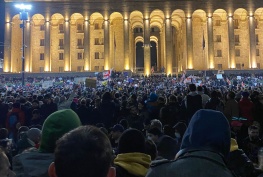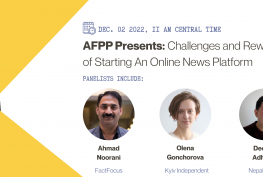By Arshad Dogar
Welcome to the world of OjO!
OjO, Spanish for ‘eye’, is the name of a theater, produced by Pittsburgh’s own Bricolage Production Company. The experimental company aims to immerse artists and audiences in “adventurous theatrical experiences” that spontaneously foster connections and alter perceptions.
I had a chance to participate in one of its rehearsals before the formal opening of a 10-day-long 55th Three Rivers Arts Festival. My colleague Mary Thomas, art critic at the Pittsburgh Post-Gazette, accompanied me to a stunning 90-minute performance that made us laugh and wonder what they had done with us
The interactive performance ended with thought provoking lessons about the blessings of God, especially the ability to see. It encouraged participants to experience what handicapped people must go through, by asking them to move blindfolded with the help of a guide.
As we entered a building, a front desk man at a supposedly bare bones travel agency, welcomed us in Spanish. He kept on speaking Spanish, which we could not understand. His gestures helped us to comprehend a little bit. He handed over some items including a plastic rain coat. The front desk man made us realize the importance of language.
Still uncertain about the next step, we entered another small, poorly-lit room and sat on benches.
A smart young actor appeared, welcoming us to the world of OjO. He told two different stories and concluded that we wished to ride a horse.
We left the room and a boy standing outside tasked us to find a person beating a drum. We met with the drumbeater. She asked us to call her relative. We made a call and the receiver of the call directed us to meet a ‘seer’ in a nearby building. The actors asked us to put on blindfolds and started telling a story.
The journey had begun.
We rode a ‘horse’ blindfolded. The horse walked through a street in the rain. We heard Indian songs and birds chirping in the background. The guide said: now you are in India.
We got off the horse. An actor led us to another long but narrow alley. After sometime, we reached a noisy location, maybe a bar. Ladies invited us to dance.
Later, we removed blindfolds and entered a big hall where a young blind lady welcomed us. The energetic woman presented us with red-colored punch.
She asked us to drink or at least create sipping sounds.
Finally, we walked into another room to meet the ‘seer’. We removed our blindfolds and saw an old lady sitting in a chair in front of a brail-machine. We also saw the seer’s black guide dog sleeping close to her feet.
The old lady asked us to define the qualities of each other and she typed in brail exactly what we had narrated.
Then telling us we were about to go to the final destination, they blindfolded us again and asked us to use a stick to move forward into the street. We kept on walking for 10 minutes.
We heard people saying, “They have been watching us and taking our pictures”.
Imagine our feelings throughout the journey!
 And do you know where we ended?
And do you know where we ended?
At the bank of the Allegheny River!
Hundreds of families participated in these performances.
I loved these cultural activities — not only for fun but to make us think about the Haves and Have Nots.





